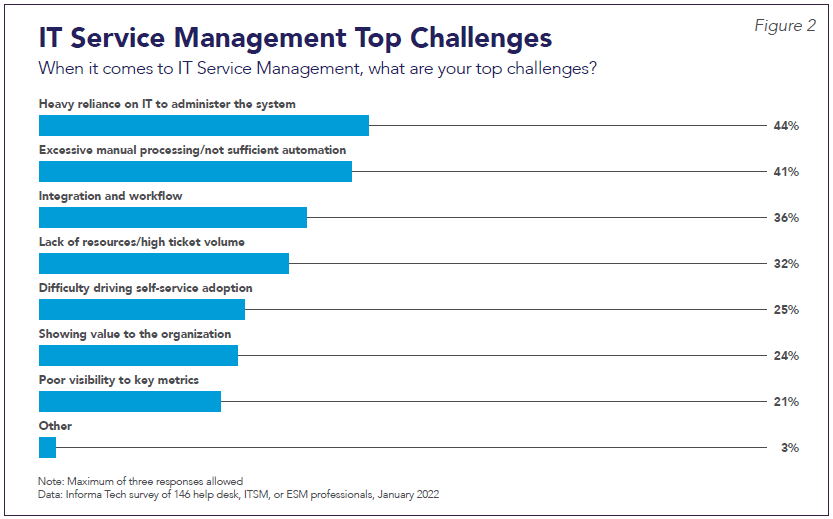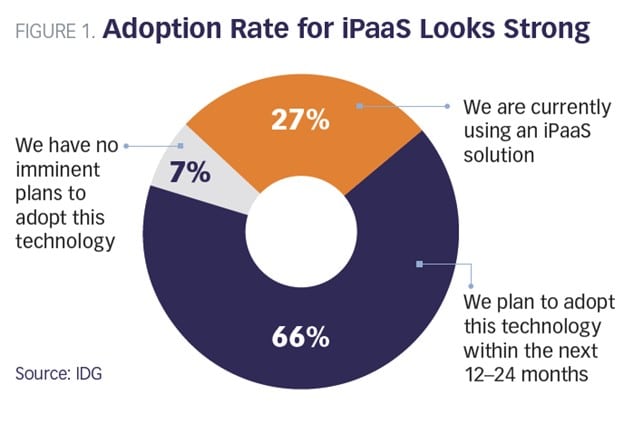How Integration and Automation Are Changing the IT Service Desk
As we look forward, enterprise integration and automation (using a tool like iPaaS) are going to fundamentally change how organizations think about service management. Most service organizations are spinning their wheels when dealing with procedural and repetitive IT Service Management (ITSM) tasks.
With an integration and automation layer, tasks such as user management, onboarding/offboarding, name updates and so on can be executed directly from the service desk platform. Without integration and automation capabilities, IT service desk technicians are doing this work manually or are relying on a patchwork of scripts and APIs.
In a recent market study with Information Week, we asked IT leaders to name their top challenges as it relates to ITSM/ESM – and first and foremost, there is an overwhelming need for more simplified system administration. When an ITSM/ESM software platform is complex to configure and it’s complicated to create workflows or automation, it just won’t happen.
Imagine putting in a request for developers to add some basic integration or automation for better service management and then having to wait 6 months or more to get the resources assigned. These types of requests are simply not a priority project in the scheme of all IT-related initiatives for most companies. For this reason, CIOs are looking for no-code ITSM software solutions where they can easily change something like a workflow or reassign a ticket queue, or even automatically update the KB – there’s no reason for these time-consuming tasks to be handled manually anymore.

Enterprise Integration, Data Management and System Connectivity are Emerging as Top Priority
Along these lines, the service management platform has expanded well beyond IT into areas like HR, marketing, legal/compliance and facilities becoming Enterprise Service Management (ESM). When this happens, the needs expand too and the request for technical resources is once again a problem. Human resources using ESM will want to integrate and automate with their HR systems – something like a name change should not take four hours of time from IT and HR resources. Onboarding is another time-consuming task – probably the biggest example of a time drain on the organization as a whole – and all of this can be automated without the need for developers.
In the last decade, organizations have found themselves needing to evolve to meet the needs of a growing, fast-paced technology-driven customer and employee base. As these needs have been addressed, a new challenge has emerged. As a result, lines of business are purchasing and managing their own technology stacks independently from central IT. On average, any organization now has 300-500 point-to-point solutions while still managing older legacy platforms.
All this complexity has resulted in a situation where:
- Redundant data is housed in multiple systems and therefore, it’s out of sync.
- Only certain users can get to the data or work within each system.
- Manual processing is increasing because we now need to go from system to system.
This growing fragmentation of work is a strategic challenge for senior business leaders. Because leaders don’t have a holistic view of the work happening across an organization and the resources dedicated to each project, it can hinder them in making the kind of speedy and well-informed decisions that are possible when you have an integrated view of your business. In addition, the disparate systems mean there are likely employees across the organization spending a significant portion of their day reconciling data across applications.
One might say a solution to this is to build in-house integrations for these applications. However, that can be slow and costly for organizations, leading to missed business opportunities and inefficient operations. Point-to-point integrations also present challenges around error and security risks. That’s why companies are turning to integration platform as a service (iPaaS). iPaaS is an easy-to-use integration and automation product that can be deployed by employees across the organization.
At Pima County, they are using TeamDynamix ITSM with iPaaS to automate repetitive tasks that cause “toil” for the organization. While they are starting with the implementation of these tools in IT, there are plans to put them in place throughout the organization for ESM applications as well.
“People feel so much more empowered and have so much more worth when they are doing things that are intellectually rigorous and challenging versus when they are just repeating the same mechanical actions over and over and over with very little thought,” Mark Hayes, information technology leader, said when explaining the interest in automating tasks like password resets, onboarding/offboarding and more. “…investing in tools that allow our employees to engage in meaningful work is something that’s important to us as an overall IT organization.”
Hayes continued, “The drudgery of working through mundane, repetitive tasks doesn’t exist just in IT. I think the more we can reduce toil within the departments that we support, the more people are going to buy in and understand the value of what we’re trying to achieve. There’s nothing like success to breed more success, and once other departments see the benefits they’re going to want these tools too.”
Pairing ITSM/ESM Platforms with iPaaS
ITSM/ESM platforms all have some level of workflow and automation, but this is mostly only within the actual system itself. You can automatically route a ticket or automatically close something and so on, but that is not really enterprise automation.
First, you need a platform that can quickly integrate with the hundreds of applications that exist in the organization – not something homegrown that can take years to get off the ground. That’s why iPaaS is being adopted, quickly, in many organizations. It’s a simple, easy-to-use integration and automation platform that lives next to all of the systems.
Instead of having a bespoke automation tool inside every single application – of which there are likely to be 100-300 – why not have everything housed in ONE codeless platform that’s easy to use and requires no developers.
By using iPaaS, your technical resources can learn and leverage a single hub – versus acquiring deep system expertise in all 300 applications you need to integrate. With a single system to learn, you can eliminate manual processing and the long wait times for developer resources to free up.
“In iPaaS we find the groundwork being laid for a digital future, as the products in this segment generally are lighter, more agile IT infrastructure suited for the rapidly evolving use cases around digital business.”
- BINDI BHULLAR Research Director at Gartner
Understanding How iPaaS is Going to Change Everything
What is iPaaS? iPaaS (integration platform as a service) is a cloud-based platform that connects different systems, technologies and applications on-premises or within the cloud. It enables companies to deploy and maintain integration flows without using middleware and specialized hardware between a company and third-party software or within an organization.
Companies that use several systems for different functionalities (i.e., marketing and sales) develop silos of information. These disconnected sources of information are an obstacle to data integration, making it hard for businesses to share data within the organization.
iPaaS facilitates a frictionless transfer of data between different applications, allowing businesses to streamline their workflow and improve their output. At the same time, it helps businesses to expand their offering without having to create more services. Using the integration platform, they can integrate those services with existing software and provide their users with a unified, more robust solution.
At NaphCare, an Alabama-based company providing healthcare services and software to correctional facilities, iPaaS is being used to automate several processes including software provisioning and new account creation.
“With iPaaS, we’re looking at automating tasks to take some of the things we do manually out of the hands of IT staff, so they can be more efficient,” Barry Bowden, IT service desk manager, said.
For instance, setting up and provisioning IT accounts for NaphCare employees is currently a multi-step process. NaphCare uses a software program called Adaxes to automate the provisioning of accounts within Active Directory, but IT staff still have to coordinate with both HR staff and the managers of various departments to confirm what IT privileges employees should have—such as whether they should get a free or paid Zoom account. Bowden’s staff includes one full-time employee whose sole responsibility is to perform this work.
With TeamDynamix, NaphCare has created automated workflows for contacting HR and department heads to collect the necessary information. Using iPaaS, Bowden plans to connect TeamDynamix with Adaxes and build a customized workflow to create new user accounts from this information.
Automating this process will enable it to be completed in under five minutes, he says, with very little human intervention needed—freeing up the IT employee responsible for this task to do more strategic work, “That employee can be reallocated to other areas to work on more complex projects,” Bowden said.
There are also plans to automate software provisioning for programs like Microsoft Office.
“It will take me a week, right now, to go in and install Microsoft Office on all the accounts that request it. With automation in place, I won’t need to touch those requests unless there’s a problem. People will be able to go to our portal, put in the request and automatically get the software,” Bowden said. “That’s a full week of time I can get back to work on other things. That will be a huge benefit for us.”

Supercharged ITSM is the Way Forward
Automation and workflow management provides the fundamental infrastructure underpinnings for ITSM success. ITSM groups that are able to manage the flow of service requests as effective project managers—and automate away the most time-consuming tasks—are the ones that maximize their resources in the pursuit of servicing end-users with minimal delay or frustration. This is why we need to supercharge ITSM with automation and integration using iPaaS.
Currently, a little more than half of organizations engage in some sort of resource planning and workload balancing and just under half have a formal intake, prioritization and review process in place. That’s good, but it leaves the other half with no official method for starting and tracking tickets – likely many of these groups have staff accepting user requests in the parking lot, on disparate messaging platforms and during conference calls about other issues.
In a resource-constrained world, this creates a push-me, pull-me chaos where no one is on the same page or able to prioritize the most important projects and tickets in an orchestrated manner. It leaves IT in a constant cycle of repositioning resources, budgets and expenses, while at the same time, failing to adequately set expectations with users who constantly want to know why IT hasn’t addressed their issues.
What to see how this works in Real Life? Check out these 6 cool iPaaS stories of how companies are saving time and improving service.